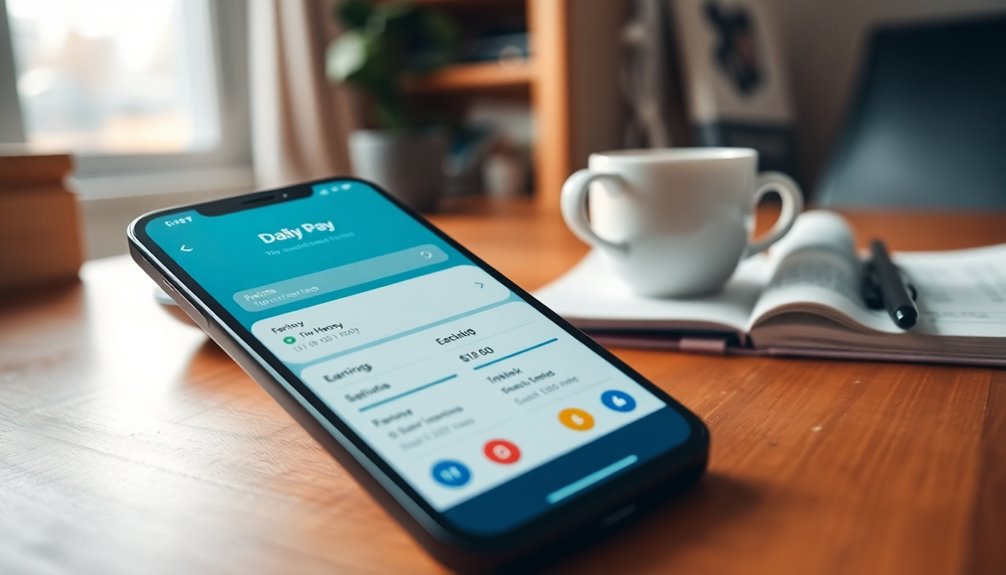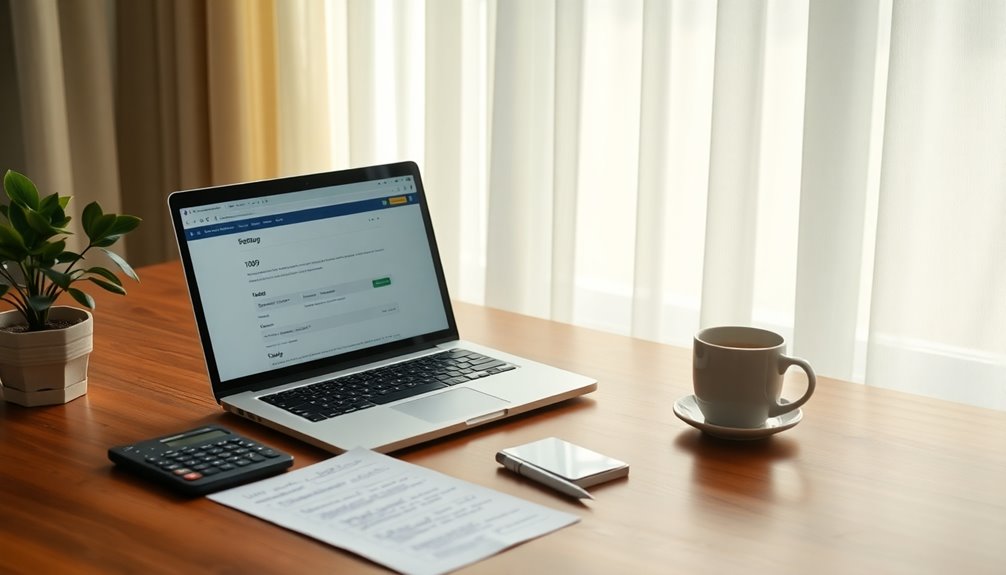To track expenses without losing receipts, embrace digital tools that capture and organize your receipts automatically using OCR technology, ensuring accurate data extraction. Choose user-friendly expense management apps that sync seamlessly with your bank accounts and support multiple currencies. Regularly back up your data securely in the cloud and use clear labels to categorize your expenses. Set routines for uploading and reconciling receipts so your records stay organized—keep going to discover even smarter tips.
Key Takeaways
- Use OCR-enabled receipt capture apps to convert physical receipts into searchable, organized digital formats.
- Sync receipts automatically with cloud-based expense management tools for secure storage and easy retrieval.
- Categorize and label receipts with clear tags, dates, and vendors for quick identification and compliance.
- Automate expense categorization and approval workflows to reduce manual errors and save time.
- Regularly back up and encrypt data to ensure receipts are protected and never lost.
Embrace Digital Receipt Capture
Digital receipt capture transforms how freelancers manage their expenses by making the process simpler and more reliable. With this technology, you can convert physical and digital receipts into structured, searchable formats, saving you time and reducing errors. The receipt format varies, but OCR technology extracts key data like vendor, date, and total amount accurately—often over 95%. Data security is a priority; your receipts are stored securely in the cloud or on your device, protecting sensitive financial information. This digital approach eliminates the risk of losing or damaging paper receipts and streamlines expense tracking. Automated data extraction and organization mean you spend less time on manual entry, helping you stay organized and compliant. Embracing digital receipt capture makes expense management faster, safer, and more efficient, especially since it often includes error rates as low as 0.55% compared to manual entry. Additionally, integrating with expense management software can further automate the process and improve accuracy.
Select the Right Expense Management Tools
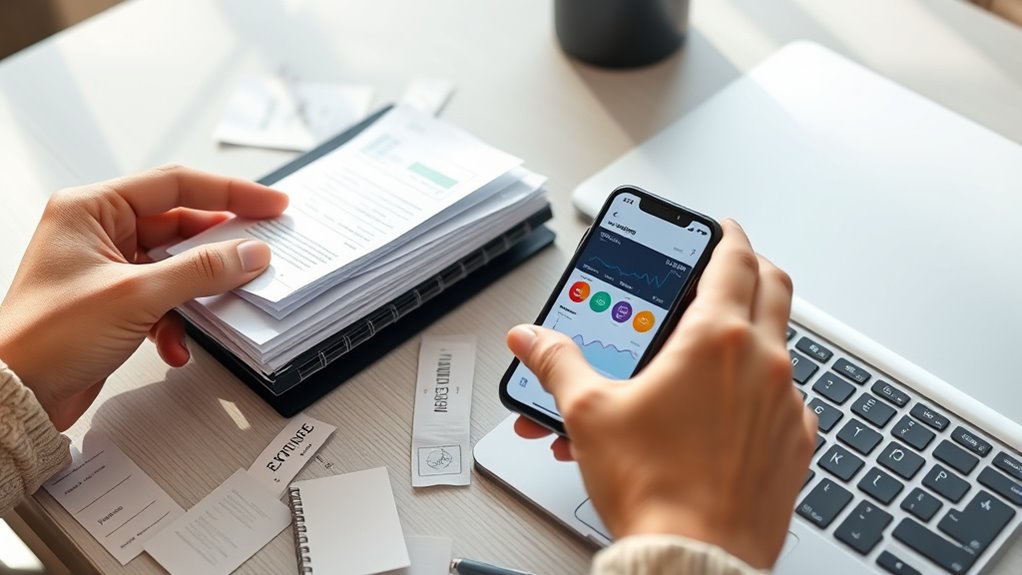
Choosing the right expense management tools starts with checking if the app works smoothly with your existing systems. You want something that’s easy to use, so you can focus on your work, not learning complicated features. Don’t forget to look for automation options that can save you time and reduce errors in tracking your expenses. Modern tools improve efficiency over traditional methods, making your expense management process more streamlined and accurate. Additionally, selecting tools familiar to freelancers can help you better adapt to your unique financial tracking needs.
Evaluate App Compatibility
Evaluating app compatibility is essential to guaranteeing your expense management tools integrate smoothly with your existing financial workflows. You need to check app platform compatibility across web, iOS, and Android to ensure access on all your devices. Look into software integration options, especially with popular accounting solutions like QuickBooks, Xero, or FreshBooks, to streamline data sharing. Automated bank transaction importing reduces manual entry errors, while synchronization with invoicing and time tracking tools offers a unified view of your finances. Consider whether the app supports multi-currency for international work, AI-powered receipt scanning for efficiency, and mileage tracking for travel expenses. Many popular apps support multiple currencies and automatic transaction imports, ensuring these features work well together guarantees your expense management system is reliable, accessible, and tailored to your freelance needs. Additionally, assessing the reliability of data synchronization can prevent discrepancies and ensure your financial records stay accurate across platforms.
Prioritize User-Friendly Design
Prioritizing user-friendly design when selecting expense management tools guarantees you can easily log, review, and manage your expenses without frustration. Look for apps that offer smooth user onboarding and reliable customer support, making setup and troubleshooting simple. Choose tools with intuitive interfaces, especially for receipt capture and entry, so you don’t waste time figuring out features. Cross-platform support ensures you can access your expenses anywhere, on any device, with real-time sync via cloud platforms. Offline functionality is a bonus for capturing receipts on the go without internet. Here’s a quick overview: According to recent studies, over 70% of users report increased efficiency when using well-designed expense apps.
| Feature | Importance | Example Use Case |
|---|---|---|
| User onboarding | Easy setup, quick learning | New users get started faster |
| Customer support | Troubleshooting and advice | Help when facing issues |
| Cross-platform support | Accessibility everywhere | Log expenses from any device |
| Offline functionality | Capture receipts without net | Work offline, sync later |
Consider Automation Features
Have you considered how automation features can streamline your expense management process? AI automation can automatically categorize expenses, reducing errors and maintaining consistent records. OCR scans receipts to extract key data, saving you time on manual entry. Policy compliance features flag non-compliant expenses before approval, helping you enforce spending rules effectively. Look for tools that offer:
- Seamless integration with accounting platforms like QuickBooks and Xero
- Real-time alerts for policy violations and unusual transactions
- Automated workflows for faster expense approvals and reimbursements
Automation features can significantly cut down processing times, enabling you to manage your freelance expenses more efficiently. These features not only reduce manual labor but also improve accuracy and compliance. By choosing expense management tools with strong automation capabilities, you can save time, minimize mistakes, and keep better control over your freelance finances.
Organize Your Receipts With Clear Labeling
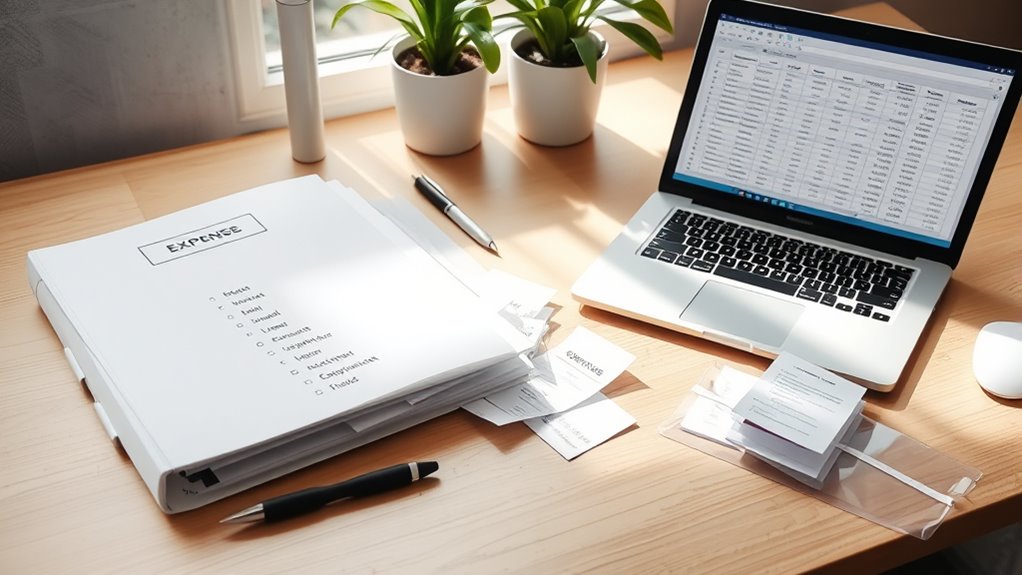
Organizing your receipts with clear labeling is essential for quick retrieval and accurate record-keeping. Proper physical labeling helps you easily identify expenses by category and date, streamlining receipt organization. Use consistent labels with specific details like expense type, vendor, date, and location. Color-coded labels or stickers can visually differentiate categories, saving time during sorting. For example:
| Expense Category | Details to Include |
|---|---|
| Travel | Date, Vendor, City |
| Office Supplies | Category, Date, Vendor |
| Meals | Date, Vendor, Occasion |
| Client Expenses | Project, Date, Vendor |
Adding brief notes or keywords on receipts clarifies their purpose. Ensure labels are placed uniformly, such as top right corner, for easy access and systematic filing. Effective labeling practices also help maintain compliance with tax regulations and make expense tracking more efficient. Incorporating organized record-keeping techniques can further improve your overall expense management process.
Regularly Sync and Back Up Your Data

Keeping your expense data safe and accessible requires regular syncing and backups. This guarantees your records stay up-to-date across devices, prevents data loss from device failure or accidental deletion, and reduces discrepancies by maintaining a single source of truth. To maximize protection, focus on data encryption and choose an appropriate backup frequency. The Data Backup Service offers encrypted and compressed files sent directly to your email, making it easy to securely store and recover your data. Key practices include: – Establishing daily backups for frequent updates – Using encrypted files for secure storage – Scheduling backups weekly or monthly, depending on transaction volume. Using apps with automatic cloud syncing, encrypted data transfers, and multi-device support simplifies this process. Regularly syncing data can also support practices like sound healing science, which demonstrates that consistent routines promote overall well-being. Consistent syncing and secure backups help you avoid losing essential records and keep your expense tracking seamless and reliable.
Automate Expense Tracking Processes

Automating expense tracking processes saves you time and reduces errors by streamlining data capture and management. Using apps like Expensify or SparkReceipt, you can scan receipts automatically, ensuring receipt authenticity while minimizing manual entry mistakes. Email receipts can be forwarded to designated inboxes, with the system categorizing and extracting details instantly. Integration with accounting software like QuickBooks or Xero keeps your expense data synchronized in real time, simplifying tax compliance and reporting. Mobile photo capture of physical receipts allows quick uploads and immediate data extraction. Automated workflows can route expense reports for approval and flag policy violations, reducing oversight. Budget control features and AI-driven categorization further prevent overspending and ensure your expense management remains accurate and compliant, freeing you from tedious manual tracking.
Set Up Consistent Receipt Management Routines

To keep your expense tracking on track, set a regular schedule for organizing your receipts—weekly or monthly works best. Use digital receipt tools to scan, categorize, and store your receipts automatically, making the process quicker and more reliable. Sticking to this routine guarantees your records stay accurate, complete, and ready for tax time.
Design a Routine Schedule
Establishing a consistent receipt management routine is essential for staying organized and ensuring nothing slips through the cracks. By setting specific times—weekly or biweekly—you’ll keep receipts current and prevent backlog. Use calendar reminders to stay accountable and schedule regular expense reconciliation with bank statements to catch errors early. During each review, immediately follow up on missing or incomplete receipts to protect important documentation. Regular routines also help flag potential tax-deductible expenses, simplifying year-end filing. To reinforce your schedule, consider:
- Allocating dedicated times for receipt audits and reconciliation
- Setting recurring reminders for categorizing receipts
- Consistently reviewing and updating your storage protocols
- Receipt management can be optimized by automating parts of the process, reducing manual effort and increasing accuracy. Incorporating organized receipt storage strategies can further streamline your workflow and prevent misplaced documents.
A steady routine keeps your records accurate, streamlines audits, and minimizes errors, saving you time and stress.
Use Digital Receipt Tools
Implementing digital receipt tools can substantially streamline your expense management routine. With apps like Xero or QuickBooks Online, you can snap photos of receipts, creating a seamless paperless workflow. OCR technology automatically reads receipt details such as date, amount, and vendor, reducing manual entry errors. Cloud storage integration ensures receipts are securely stored and easily accessible anytime, facilitating quick receipt retrieval and organized receipt storage. Many tools sync with bank accounts, automatically importing and categorizing expenses, saving you time during tax season. Features like instant receipt matching and automated expense classification further simplify your routine. Using these digital tools helps avoid lost or damaged paper receipts, guaranteeing your records are accurate and audit-ready. This approach keeps your expense tracking efficient, organized, and stress-free.
Use Cloud Storage for Secure and Accessible Receipts
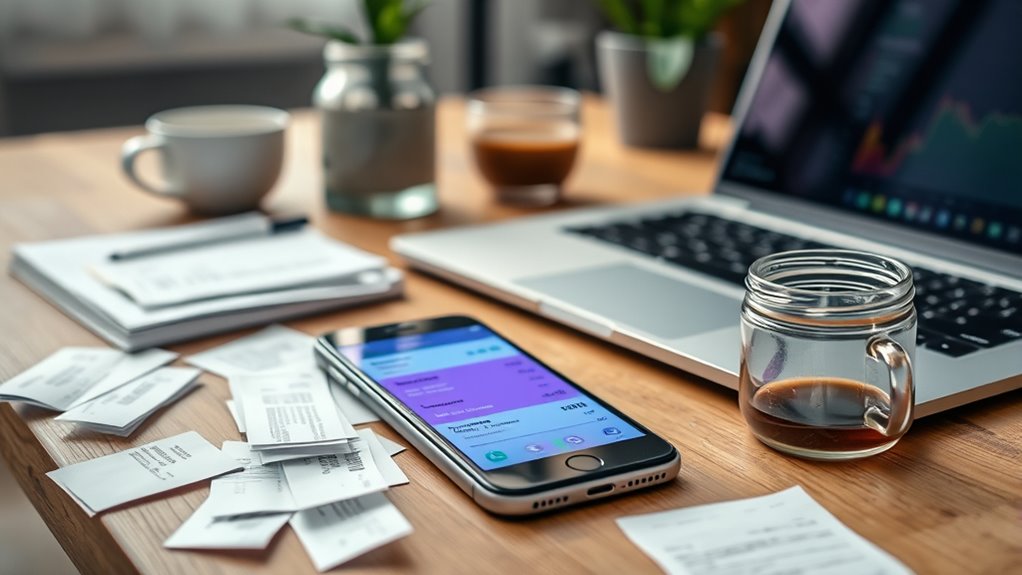
Use cloud storage helps you stay organized and guarantees your receipts are accessible whenever you need them. It offers a secure, centralized place to store digital copies, reducing the risk of physical loss or damage. To keep your data private and compliant with cloud standards, choose providers with strong encryption (like 256-bit AES) and strict access controls. The global cloud-based receipt management market is projected to reach USD 11.36 billion by 2034, growing at a CAGR of 10.7%. Remember to:
- Regularly update your security settings
- Verify cloud compliance with relevant data privacy standards
- Use role-based permissions to limit access
- Be aware of privacy policies and how your data is handled by cloud providers.
Frequently Asked Questions
How Can I Ensure My Receipts Are Properly Categorized for Tax Deductions?
To guarantee your receipts are properly categorized for tax deductions, focus on effective receipt organization and expense categorization. Use a digital system or apps to scan and label receipts immediately, sorting them into relevant categories like supplies, travel, or marketing. Keep your records clear and consistent, including details like date, vendor, amount, and business purpose. Regularly review and reconcile your categories with your bank statements to maintain accurate and organized documentation.
What Are the Best Practices for Handling International or Foreign Currency Receipts?
Ever wondered how to handle foreign currency receipts smoothly? You need solid multi currency accounting practices, ensuring receipts match the invoice’s transaction currency and the bank account’s base currency. Keep exchange rate management sharp by automating updates and reviewing rates regularly. Always obtain original receipts in the foreign currency, categorize expenses clearly, and track exchange fees diligently. These steps prevent errors and maximize accuracy, making international expense tracking straightforward and reliable.
How Often Should I Review and Reconcile My Expense Records?
You should review and reconcile your expense records weekly or biweekly to keep your record keeping accurate. Regular expense audits help you catch errors early, prevent missing receipts, and guarantee your financial data stays current. Setting reminders and dedicating specific times for this task keeps your bookkeeping organized. Frequent reviews also make tax prep easier and help you manage cash flow effectively, avoiding surprises at year’s end.
Can Automated Tools Identify Deductible Expenses Automatically?
This feature can revolutionize your expense tracking! Automated tools use receipt scanning and expense categorization to identify deductible expenses effortlessly. They analyze receipts instantly, classifying expenses into accurate categories, reducing errors and saving you tons of time. With machine learning, these systems automatically spot deductible items, ensuring nothing slips through the cracks. Say goodbye to manual entry and hello to smarter, hassle-free expense management that keeps your finances on point!
What Security Measures Protect My Digital Receipts From Hacking or Data Loss?
To safeguard your digital receipts from hacking or data loss, you should use strong encryption protocols during transmission and storage. Implement access controls like multi-factor authentication and user permissions to restrict who can view or modify your receipts. Regularly update your security software, and stay vigilant about suspicious activity. These measures guarantee your data remains secure, private, and protected from unauthorized access, giving you peace of mind.
Conclusion
Think of your receipts as the roots of your freelance tree—strong, organized roots keep your financial future healthy and thriving. By embracing digital tools and routines, you’re planting seeds for growth and stability. When you regularly back up and organize your receipts, you nurture your business’s foundation. With each well-kept record, you’re watering your success, ensuring your freelance journey blossoms with confidence and clarity. Keep your roots strong, and watch your business flourish.



